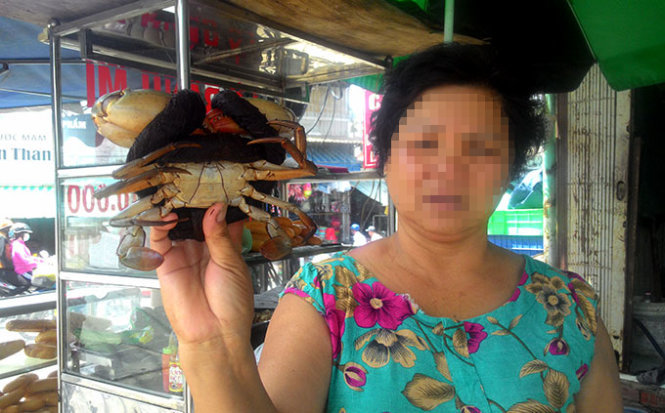You do not need to go to any tourism spots to be cheated by scam vendors, as some of the street peddlers in Ho Chi Minh City too have tricks to leave you seething with anger while your money has left your pocket.
Such dishonest vendors are blatantly continuing their business every day, because they are still able to find buyers, who seemingly see the cheating as a ‘common practice.’
Selling crabs with heavy strings tied to their claws is not the only example for the scams some street peddlers use target consumers in the city.
On many streets across Ho Chi Minh City, it is not difficult to spot fruit peddlers, who stand behind their trolleys or bikes, with banners displaying the products they sell and their prices.
These signs all share a common feature: the price is written in giant size, compared to the tiny text for the weight.
And they do not quote price per kg. The small text for weight, which can only be seen clearly when you stand next to the sign, reads “1/2kg.”
 The sign may read '10,000 1kg' from afar, but it is in fact '10,000 1/2kg'. Photo: Tuoi Tre
The sign may read '10,000 1kg' from afar, but it is in fact '10,000 1/2kg'. Photo: Tuoi Tre
By this method, a sign that reads ‘Rambutan, VND10,000 1/2kg,” will read something like “Rambutan, VND10,000 1kg” when seen from afar, as the ‘/2’ is written as small as possible.
“They write the ‘1’ figure in big and bold font, and the ‘/2’ is in pale color,” Thanh Hue, a consumer, told Tuoi Tre (Youth) newspaper.
Hue said she only fell victim to the trick “during the first months after [I] moved to Saigon,” and now she and many other consumers are too familiar with such dubious price signs.
Still, there is yet another trick for fruit peddlers to display a misleading sign.
Along the Phan Xich Long Street in Phu Nhuan District these days are vendors who sell Hanoi peach, behind signs that apparently read “3,000 dong 1kg.”
However, when viewed from a close distance, the signs turn out to be “13,000 dong 1/2kg,” as the “1” in “13” is written in a way that makes it almost invisible when seen afar.
For candy lovers, beware when buying the Vietnamese peanut brittle packed in plastic bags.
 The right piece of candy is the best of the whole package. Photo: Tuoi Tre
The right piece of candy is the best of the whole package. Photo: Tuoi Tre
The very first piece of the candy, put atop of the bag and the only one you can see when they are on display, will look so delicious and tasty that you will not hesitate to open the wallet for them.
But when you are back home and unwrap the candy, you will find all of the other pieces of the brittle way worse than the first one. The sellers only need one best piece to dupe consumers into buying the other uglier ones.
Impunity
While many consumers are not unfamiliar with such dishonest traders, they just ignore it.
“The vendors keep cheating customers without being punished by any regulatory agencies, and we have no choice but to accept it,” Ngoc Hoa, a local consumer, said.
Dr. Huynh The Du, a lecturer of the Fulbright Economics Teaching Program, said if people continue seeing the phenomenon as a common practice, the scams will continue forever.
Those who accept the tricks by these peddlers and continue buying their products will become their loyal customers, he said.
And the dishonest vendors will only stop their business when there will no longer be any local buyers.
Duong Minh, a Tuoi Tre reader, said people should become “smart buyers” and have no tolerance to vendors with dishonesty.
“When you are cheated, do not let it go but report to authorities,” he said.
“You should have the issue completely solved, as it will give a warning for the sellers.”
Like us on Facebook or follow us on Twitter to get the latest news about Vietnam!























































